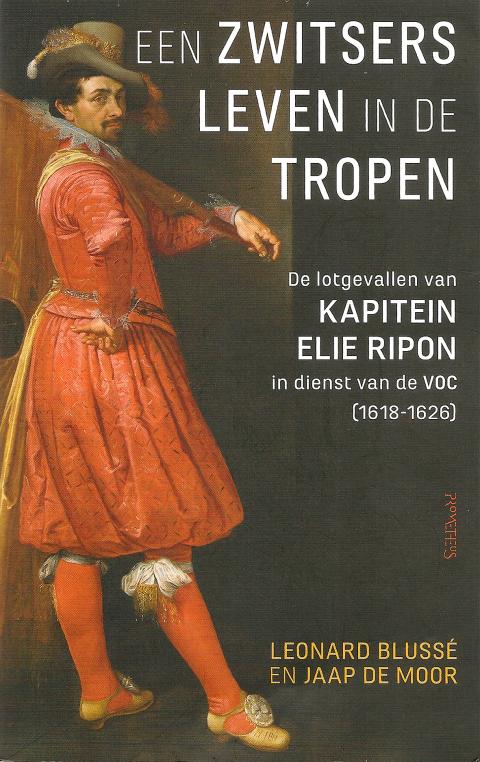The Swiss in the 17 century were known as Europe’s foreign legionnaires: in the many conflicts and wars within Europe, one was bound to find Swiss regiments that fought for the highest bidder. The current Swiss Guard at the Vatican still reminds us of those days.
At the time, Switzerland consisted of a number of poor land-locked cantons, with very little economic activity, so young Swiss men traveled to other countries in search of a livelihood and adventure, selling their military prowess.
One of those men was Elie Ripon, a French-speaking Swiss soldier from Lausanne, who in 1617 traveled to the Netherlands to try his luck. He initially served on a whaling expedition to Greenland, but took a serious dislike to the activity, so the next year he signed up with the Dutch East India Company, and was sent to the Far East.

Ripon wrote a diary in French, which collected dust in an attic for a couple of centuries until 1865, when the manuscript was discovered in an old home in Bulle, in the Swiss canton of Gruyere. In the 1980s the researcher Yves Giroud published the French manuscript, while the Dutch version, on which this review is based, was published in 2016 by Leonard Blusse of Leiden University and Jaap de Moor.
THE DUTCH IN BATAVIA
In his diary, Ripon gives a colorful description of the trip from The Netherlands via Cape of Good Hope to Batavia (present day Jakarta, Indonesia), which lasted about half a year. There he is immediately engulfed in the fighting between the Dutch — who in 1619 had just built a small fortress near the entrance of the harbor — and the British, who together with the local Javanese sultan try to push the Dutch out.
The siege of the small fortress lasts some four months, but then Dutch governor-general Jan Pietersz Coen returns with reinforcements from the Moluccas, and with a large contingent of soldiers is able to defeat the British and the Javanese. Ripon is quickly promoted and is soon a captain in the army of the East India Company.
After the pacification of the area around Batavia, Ripon is sent to various locations in the Moluccas as well as to the islands to the East of Bali. He describes the local population and its customs, as well as exotic plants and animals.
RIPON ON TAIWAN
For Taiwan, the most interesting part of the diary is the period 1622 to 1624, when Ripon is sent to the Chinese coast with a fleet of 12 ships under Commander Cornelis Reijersen. The purpose of the trip is to establish a trading presence there.
And if taking Macau is not successful, they are to establish a fortress on Penghu to trade with the Chinese coast from there, and at the same time inhibit the trading operations of both the Spanish, who had established themselves in Manila in 1571, and the Portuguese, who had established a stronghold in Macau in 1557.
The Portuguese had been the earliest Western explorers and traders in the East Indies, but in the late 1500s they were gradually overshadowed by Spain. However, in the early 1600s, the Netherlands — which was fighting its own war of independence against Spain (1568-1648) — came up as a major trading power, and fought the Spanish and Portuguese wherever they could.
The arrival of the Dutch fleet off Macau doesn’t end peacefully: the Dutch land, and attempt to push out the Portuguese, but the attack is unsuccessful, and the Dutch have to retreat: Ripon gives a lively description of the fighting that took place. He himself just barely escapes.
At the time, Macau hosted about 2,000 Portuguese, 20,000 Chinese and around 5,000 African slaves, brought by the Portuguese from their colonies in Angola and Mozambique. It was actually mostly the Africans who fought off the Dutch assault; a Dutch officer reported that “[o]ur people saw very few Portuguese” during the battle.
The defeat at Macau necessitates the Dutch plan B: The remaining ships and troops sail to Penghu, where they arrive on July 5, 1622. There they start to build a simple fortress, and even disassemble one of the Dutch ships in order to have wood and other material to build the buildings: the island is so bare that there were no trees that could be used for this purpose.
In December 1622 the fortress is finished, and the remaining Dutch ships sail to both the Chinese coast for trade, and to Manila in order to block Spanish and Chinese ships from entering the harbor. Ripon sails on a ship to the coast, but found that the Chinese had little inkling to trade with the Dutch.
After about a year of skirmishes back and forth between the Dutch, the Chinese and the Spanish, the Ming Dynasty authorities along the Fujian coast decide that they want to push out the Dutch: in early 1624 they land a large force of some 10,000 soldiers on the North side of the island, and start to threaten the small Dutch fortress.
THE DUTCH AND ABORIGINES
It never came to real fighting: through the intermediary services of a disgraced former Ming official who had made his name in piracy, Li Tan (李旦, “Captain China”), the Dutch and the Chinese authorities come to an agreement that the Dutch will vacate the Penghu Fortress, and move “beyond Chinese territory.” In August 1624 the Dutch moved to a sandy beach at Tayouan, present-day Anping District (安平) in Tainan.
The interesting thing is that Ripon’s diary tells us that more than a year earlier, the Dutch had already set foot on Formosa: in October 1623, when the Dutch were still firmly established at Penghu, Ripon was sent out to Tayouan to build a small fortress there. He was thus one of the first Western observers to visit Aboriginal villages in the area.
He and his men first befriend the people of Bacaloan — present-day Anting District (安定) in Tainan — giving them small presents. He visits several of the surrounding villages, and describes the people, their customs, clothing, homes and daily activities. He also describes the headhunting, which went on from the time the harvest was in until the next planting season.
Interestingly, his friendship with the people of Bacaloan has a negative effect on the people of neighboring Mattau: they are jealous that they didn’t receive the same presents, and attack Ripon and his soldiers. The animosity with “the giants of Mattau” (these Aborigines were apparently quite tall) would last another decade until the pacification of the area in 1635.
Between October 1623 and March 1624, the small fortress, named Fort Oranje, withstands a couple of bad earthquakes, a typhoon, and a major attack by Mattau. However, at the end of March, the higher-ups decide to concentrate all Dutch forces at the Penghu Fortress, and Ripon is told to demolish the fortress at Tayouan and return to Penghu with his men.
However, only a few months later, when the Ming Emperor’s emissary tells the Dutch to “move beyond Chinese territory,” the Dutch return to Tayouan and establish a more permanent presence there. The agreement was signed on Aug. 24, 1624, and only four days later, the new governor, Martinus Sonck, leaves for Formosa to build a new fortress there. He arrives on Aug. 31, 1624, and immediately starts with the construction of what was to become Fort Zeelandia.
Ripon stays behind to oversee the dismantling of the Penghu Fortress, which is completed in just five days, from Sept. 8 through Sept. 13, 1624. He and his soldiers leave Penghu on Sept. 16 “with flying banners and the sounding of the drums,” arriving in Formosa a couple of days later.
There the construction of the new fortress has already started, so Ripon and his soldiers are tasked with finding food for the quickly expanding population. He goes hunting, and carries back some hares, pheasants and deer.
However, Ripon’s further stay at Formosa is short-lived: he strongly disagrees with the way the new governor, Cornelius Sonck, treats his soldiers and sailors, and decides to return to Batavia. In early December 1624, Ripon sails on the ship North Holland, and leaves Formosa far behind him.
This is a brief description of Ripon’s adventures in Formosa. He returns to the East Indies, and goes on to many more explorations of faraway islands, colorful descriptions of the local population and fights against the Spanish, Portuguese, and local adversaries in Sumatra, Borneo and the Moluccas.
After a couple more years of such an adventurous life, Ripon returns to his homeland, and in December 1626 sets sail back to Europe on the Dutch sailing ship Ter Tholen. According to Dutch records, the ship, together with another sailing ship, the Schiedam, arrives in the Netherlands on July 25th 1627. After that, we lose track of Ripon.
Gerrit van der Wees is a former Dutch diplomat. From 1980 through 2016 he published the Taiwan Communique. He currently teaches History of Taiwan at George Mason University.

Feb. 17 to Feb. 23 “Japanese city is bombed,” screamed the banner in bold capital letters spanning the front page of the US daily New Castle News on Feb. 24, 1938. This was big news across the globe, as Japan had not been bombarded since Western forces attacked Shimonoseki in 1864. “Numerous Japanese citizens were killed and injured today when eight Chinese planes bombed Taihoku, capital of Formosa, and other nearby cities in the first Chinese air raid anywhere in the Japanese empire,” the subhead clarified. The target was the Matsuyama Airfield (today’s Songshan Airport in Taipei), which

China has begun recruiting for a planetary defense force after risk assessments determined that an asteroid could conceivably hit Earth in 2032. Job ads posted online by China’s State Administration of Science, Technology and Industry for National Defence (SASTIND) this week, sought young loyal graduates focused on aerospace engineering, international cooperation and asteroid detection. The recruitment drive comes amid increasing focus on an asteroid with a low — but growing — likelihood of hitting earth in seven years. The 2024 YR4 asteroid is at the top of the European and US space agencies’ risk lists, and last week analysts increased their probability

On Jan. 17, Beijing announced that it would allow residents of Shanghai and Fujian Province to visit Taiwan. The two sides are still working out the details. President William Lai (賴清德) has been promoting cross-strait tourism, perhaps to soften the People’s Republic of China’s (PRC) attitudes, perhaps as a sop to international and local opinion leaders. Likely the latter, since many observers understand that the twin drivers of cross-strait tourism — the belief that Chinese tourists will bring money into Taiwan, and the belief that tourism will create better relations — are both false. CHINESE TOURISM PIPE DREAM Back in July

Could Taiwan’s democracy be at risk? There is a lot of apocalyptic commentary right now suggesting that this is the case, but it is always a conspiracy by the other guys — our side is firmly on the side of protecting democracy and always has been, unlike them! The situation is nowhere near that bleak — yet. The concern is that the power struggle between the opposition Chinese Nationalist Party (KMT) and their now effectively pan-blue allies the Taiwan People’s Party (TPP) and the ruling Democratic Progressive Party (DPP) intensifies to the point where democratic functions start to break down. Both